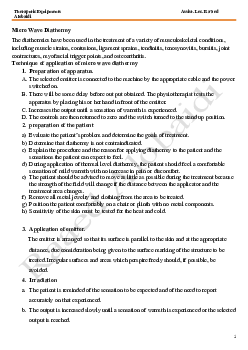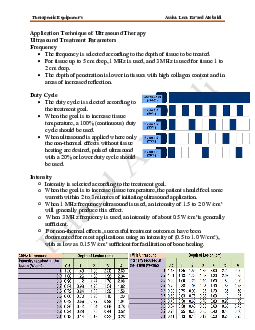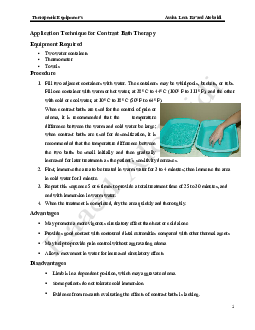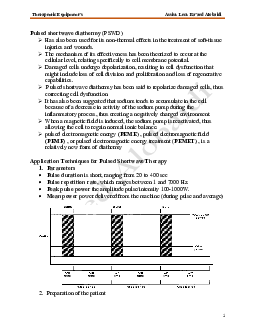





Preview text:
lOMoARcPSD|36041561
Therapeutic Equipment’s Assist. Lect. Ra’aed Alobaidi Short –Wave Diathermy
Short –wave diathermy current has a frequency of between (107 and 108 Hz) and
sets up radio waves with wave length of between 3 m and 30 m the use of any
current with in this range is classed as a short wave diathermy, but that commonly
used for medical work has a frequency of 27.12 MHz this current is generated in a
machine circuits. Short wave diathermy provides as deep form of heat as any
available to the physiotherapist
Shortwave Can Be Used in Two Modes
1. Thermal- continue (energy is emitted all the time).
2. Non thermal-pulsed (energy is emitted part of the time).
Techniques of short wave diathermy:-
1. Testing of the machine
The machine should be tested before use. The operator places her hand
between the electrodes, switches on and turns the machine then increases the
current until a comfortable warmth is felt, or, tested with a neon tube.
2. Preparation of the patient
a) The couch, chair or table that is used for supporting the patient should
not contain metal, as this is liable to distort the electric field and to be
heated by currents which may be induced in it. Raaed Alobaidi
b) Clothing should be removal from the area of treatment. If the clothing
is not removed, the necessary inspection of the skin before and after
treatment is not possible, and the skin electrode distance and position
of the electrodes cannot be judged accurately. The presence of
clothing makes it difficult for the patient to appreciate the sensation of warmth. 1
Downloaded by Nga T??ng (ngahuong55@gmail.com) lOMoARcPSD|36041561
Therapeutic Equipment’s Assist. Lect. Ra’aed Alobaidi
c) Metal objects in the clothing may easily pass undetected .It should be
removed from the vicinity of the area to be treated i.e. at least (30 cm) away from the electrodes.
d) Wounds and sinuses must be cleaned and covered with dry dressing before commencing treatment.
e) The area to be treated must be dry (if the area is damp the moisture on
the surface of the skin is heated quickly and gives rise to a sensation
of warmth which limits the intensity of current that can be applied) .
f) The patient must be comfortable and the part to be treated must be fully supported.
g) Any movement may alter the skin electrode distance.
h) Skin sensation must be tested before the first treatment.
i) Hearing aid must remove away from the machine.
3. Type of electrode six main variations in electrodes are commonly available:
a)Flexible pads: consist of metal electrode encased in rubber and produce an electrostatic field.
b)Space plates: consist of rigid metal electrode encased in a Perspex cover electrostatic field. Raaed Alobaidi
c) Coil or cable electrode consist of a wire with plugs at either end electromagnetic field d) The 2
Downloaded by Nga T??ng (ngahuong55@gmail.com) lOMoARcPSD|36041561
Therapeutic Equipment’s Assist. Lect. Ra’aed Alobaidi
monode : Flat, rigid coil encased in Perspex cover electromagnetic field.
e) The minode: conical rigid coil encased in Perspex cover electromagnetic field.
f) The drum : conical rigid coil encased in Perspex cover magnetic field.
g) The diplode electrode, consists of a flat coil electrode encased in
Perspex cover with two wings electromagnetic field.
Factors influence field distribution in short wave diathermy
1) Spacing: allows the lines of force in the electrostatic field to diverge
before entering the tissue. This prevents concentration of heat in the
superficial tissues and ensures more heating through the part. Spacing provided by :
1) Wrapping flexible pads in towel
2) Flat felt spacing pads between pad electrode and skin.
3) Air when using space plates.
a) Normal spacing even field distribution.
b) Increased spacing deep field concentration.
c) Decreased spacing superficial concentration.
It has been suggested that for most short wave sources at maximum output
spacing of about 4 cm to the maximum that will give the greatest absolute Raaed Alobaidi heating of the deep tissues.
Conversely the minimum skin electrode distance is about 2 cm.
Note: the spacing refers to distance of the metal electrode, not the plastic cover, from the skin.
2. Air in cavities: as sinuses or uterus, the lines of force deviate air as it offers
a high resistance. As a result only the sides of air cavity will be heated. 3
Downloaded by Nga T??ng (ngahuong55@gmail.com) lOMoARcPSD|36041561
Therapeutic Equipment’s Assist. Lect. Ra’aed Alobaidi 3. Electrode size :
If the electrodes are too small than the diameter of
treated part line of force will be concentrated superficially.
If the electrodes are markedly large the line of the force will be lost in the air.
Ideally, the electrodes should be slight larger than the area treated.
4. Metal: metal cause the lines of force to concentrate on the metal.
4. Application of current
a)When the patient, electrodes, and leads are in position, the current is
turned on and the circuit turned.
b)The current is then turned up slowly, to allow time for vasodilatation to
occur and for the patient to appreciate the degree of heating.
c)At the end of the treatment the controls are returned to zero.
d)The current is switched off and the electrodes are removed.
e)Notes should be made of the size and spacing of the electrode, the meter
reading, the duration of treatment and any reaction that is observed. 5. Dosage Raaed Alobaidi
The intensity of the application should be sufficient to cause a
comfortable warmth and the duration of treatment should be 20 -30 min
except for the treatment of chronic inflammatory lesions, when a duration
of at least 30 min is desirable. The treatment may be carried out daily, or on alternate days. 4
Downloaded by Nga T??ng (ngahuong55@gmail.com) lOMoARcPSD|36041561
Therapeutic Equipment’s Assist. Lect. Ra’aed Alobaidi
For acute inflammation or recent injury the duration of treatment is
limited from 5 to10 min twice daily.
Therapeutic variation in the field distribution
Application using two flexible pads or space plates:
A. The electrodes should be larger than the area
treated and spaced from skin by approximately 25 mm.
B. To concentrate heat on one aspect of the part electrode should be
unequal in size (smaller one place over the area where concentration of heat is required ).
C. You can produce concentration of heat by using equal size but with
unequal spacing (25 mm over concentrated area and more than 30 mm on other electrode).
D. Coplanar application to treat structures on one aspect of the body. If
spacing is less than 25 mm more concentration in the superficial
tissue. If spacing increase more depth achieved.
The distance between adjacent end (x) must be greater than the sum Raaed Alobaidi
of skin electrode distance (A+B) otherwise the line of force will pass directly between 5
Downloaded by Nga T??ng (ngahuong55@gmail.com) lOMoARcPSD|36041561
Therapeutic Equipment’s Assist. Lect. Ra’aed Alobaidi
electrodes rather than tissues.
E. Application using a combination of flexible pad and space plate: use
a space plate over the top of the foot, because there is less
soft tissue around the ankle joint than elsewhere in the lower
leg, the line of force concentrates at the ankle and the
sensation of heat is felt by the patient in the region.
F. Application using coil electrode:
The coil wound evenly firmly heat superficial tissue.
Pancake application heat superficial tissues.
G. Application using diplode: adjust wings of diplode parallel to the
skin of the treated area electromagnetic field will produce.
H. Application to two limbs: two flexible pads ,two space plates or
flexible pad with a space plate are used . it is essential to put a cotton
towel between the two limbs to absorb any perspiration . I. Cross fire application
For the treatment of sinuses, space plates positioned Raaed Alobaidi
diagonally ,after half of treatment time the position are
alternate . this ensures that all aspects of the sinus membrane are heated .
care must be taken to avoid direct placement over the eye ,
uterine disorders such as dysmenorrhoea. 6
Downloaded by Nga T??ng (ngahuong55@gmail.com)




